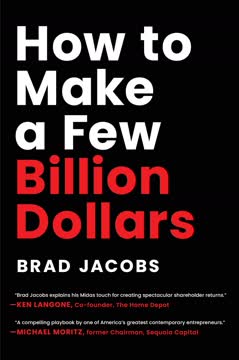نکات کلیدی
1. قدرت کلید ایجاد ارزش پایدار در کسبوکار است
قدرت: مجموعه شرایطی که امکان بازدهی متفاوت و پایدار را ایجاد میکند
قدرت ارزش را هدایت میکند. در کسبوکار، قدرت توانایی تولید سودهای پایدار و بالاتر از میانگین است، علیرغم فشارهای رقابتی. قدرت شامل دو عنصر است: یک مزیت که جریان نقدی را بهطور مادی بهبود میبخشد و یک مانع که از بهرهبرداری رقبا از این مزیت جلوگیری میکند. معادله بنیادی استراتژی این مفهوم را نشان میدهد:
ارزش = اندازه بازار * قدرت
که در آن:
- اندازه بازار = اندازه فعلی بازار * عامل رشد تنزیلیافته
- قدرت = سهم بازار میانگین بلندمدت * حاشیههای متفاوت میانگین بلندمدت
شرکتهایی که قدرت ندارند، در برابر نیروهای رقابتی که به مرور زمان سودآوری را کاهش میدهند، آسیبپذیر هستند. تجربیات متضاد اینتل در تراشههای حافظه (بدون قدرت) و ریزپردازندهها (قدرت قابلتوجه) اهمیت حیاتی ایجاد و حفظ قدرت برای موفقیت بلندمدت را نشان میدهد.
2. هفت قدرت: اقتصاد مقیاس، اقتصاد شبکه، ضد موقعیتیابی، هزینههای تغییر، برندینگ، منابع محصور و قدرت فرآیند
چارچوب هفت قدرت تمام موقعیتهای استراتژیک جذاب را پوشش میدهد، ساده نیست، در حالی که تمرکز واحد آن بر قدرت آن را به اندازه کافی ساده میکند تا توسط هر فرد کسبوکاری یاد گرفته، حفظ و استفاده شود.
درک هفت قدرت. هر نوع قدرت نمایانگر یک روش منحصر به فرد برای ایجاد و حفظ مزیت رقابتی است:
- اقتصاد مقیاس: حجم تولید بیشتر منجر به کاهش هزینههای هر واحد میشود
- اقتصاد شبکه: ارزش با پیوستن کاربران بیشتر به شبکه افزایش مییابد
- ضد موقعیتیابی: یک مدل کسبوکار جدید و برتر که پذیرش آن برای رقبا آسان نیست
- هزینههای تغییر: مشتریان با هزینههای قابلتوجهی در تغییر تأمینکنندگان مواجه میشوند
- برندینگ: مشتریان بهطور داوطلبانه برای ارزش درکشده بالاتر بیشتر پرداخت میکنند
- منابع محصور: دسترسی انحصاری به یک دارایی ارزشمند
- قدرت فرآیند: فرآیندهای داخلی برتر که تکرار آنها دشوار است
این قدرتها بهطور متقابل انحصاری نیستند؛ شرکتها میتوانند بهطور همزمان از چندین نوع استفاده کنند. به عنوان مثال، نتفلیکس اقتصاد مقیاس و اقتصاد شبکه را برای تسلط بر بازار استریمینگ ترکیب کرد.
3. استراتژی باید مسیری برای قدرت پایدار در بازارهای مهم فراهم کند
استراتژی: مسیری برای قدرت پایدار در بازارهای مهم
مانترای استراتژی. یک استراتژی موفق باید سه نیاز کلیدی را برآورده کند:
- مسیر: یک راه روشن برای ایجاد و حفظ قدرت
- پایدار: توانایی حفظ قدرت در طول زمان
- بازارهای مهم: هدفگذاری بازارهایی که به اندازه کافی بزرگ هستند تا ارزش قابلتوجهی ایجاد کنند
این تعریف تأکید میکند که استراتژی فقط درباره دستاوردهای کوتاهمدت یا برتری عملیاتی نیست. بلکه بر ایجاد مزایای رقابتی پایدار در بازارهایی با پتانسیل قابلتوجه تمرکز دارد. شرکتها باید بهطور مداوم خود را تطبیق دهند و منابع مختلف قدرت را در طول پیشرفت کسبوکار خود لایهبندی کنند تا موقعیت استراتژیک خود را حفظ کنند.
مثالهایی از استراتژیهای موفق:
- اکوسیستم دستگاهها و خدمات اپل
- تمرکز بیوقفه آمازون بر تجربه مشتری و لجستیک
- تسلط گوگل در جستجو و تبلیغات دیجیتال
4. اختراع مادر قدرت است و اندازه بازار را هدایت میکند
"من هم" کافی نیست" راهنمای ایجاد قدرت است.
اختراع رشد و قدرت را تغذیه میکند. اولین گام در ایجاد قدرت، خلق چیزی جدید و ارزشمند است. این میتواند یک محصول، فرآیند، مدل کسبوکار یا برند باشد. اختراع دو هدف حیاتی را دنبال میکند:
- درب را به قدرت باز میکند با ایجاد مزایای منحصر به فرد
- اندازه بازار را با ارائه ارزش جذاب به مشتریان هدایت میکند
سه مسیر برای دستیابی به ارزش جذاب وجود دارد:
- مبتنی بر قابلیتها: استفاده از نقاط قوت موجود برای ایجاد محصولات جدید (مثلاً Adobe Acrobat)
- مبتنی بر مشتری: حل یک نیاز شناختهشده اما برآوردهنشده مشتری (مثلاً فیبر نوری Corning)
- مبتنی بر رقبا: ارائه جایگزینی بهطور قابلتوجه بهتر برای راهحلهای موجود (مثلاً Sony PlayStation)
اختراعات موفق اغلب واکنش "باید داشته باشم" را از مشتریان برمیانگیزند، که منجر به پذیرش سریع و رشد بازار میشود. این دوره اولیه از تغییرات شدید و عدم قطعیت برای ایجاد انواع خاصی از قدرت حیاتی است.
5. پیشرفت قدرت: زمانبندی برای ایجاد انواع مختلف قدرت حیاتی است
انواع مختلف قدرت فرصت ایجاد اولین مانع را در زمانهای مختلف در توسعه کسبوکار شما ارائه میدهند.
چارچوب پیشرفت قدرت. این ابزار به کسبوکارها کمک میکند تا بفهمند چه زمانی انواع مختلف قدرت در دسترس قرار میگیرند:
-
آغاز (پیش از پرواز):
- ضد موقعیتیابی
- منابع محصور
-
پرواز (رشد سریع):
- اقتصاد مقیاس
- اقتصاد شبکه
- هزینههای تغییر
-
ثبات (رشد کندتر):
- قدرت فرآیند
- برندینگ
درک این پیشرفت برای شناسایی و بهرهبرداری از فرصتها در زمان مناسب حیاتی است. به عنوان مثال، اقتصاد مقیاس باید در مرحله پرواز ایجاد شود، زمانی که سهم بازار میتواند با شرایط مطلوب به دست آید. از دست دادن این فرصت میتواند منجر به عدم مزیت دائمی شود، همانطور که در اشتباه اپل با Apple III در دوره پرواز حیاتی رایانههای شخصی دیده شد.
6. برتری عملیاتی برای موفقیت پایدار ضروری است اما کافی نیست
برتری عملیاتی بهتنهایی کافی نیست.
فراتر از برتری عملیاتی. در حالی که برای موفقیت روزانه حیاتی است، برتری عملیاتی بهتنهایی تضمینکننده سودآوری بلندمدت نیست. این به این دلیل است که بهبودهای عملیاتی اغلب میتوانند توسط رقبا تقلید شوند، که منجر به پذیرش صنعت و فرسایش هرگونه مزیت موقتی میشود.
تمایزات کلیدی:
- برتری عملیاتی: بهبود مستمر فرآیندها و محصولات موجود
- مزیت استراتژیک: ایجاد و حفظ قدرتی که در برابر بهرهبرداری رقابتی مقاومت میکند
با این حال، در موقعیتهای تغییرات شدید مانند مرحله پرواز، اجرای عالی میتواند بسیار استراتژیک باشد. عملیات Crush اینتل، که قرارداد IBM PC را تضمین کرد، نشان میدهد که چگونه برتری عملیاتی میتواند در ایجاد قدرت بلندمدت در دورههای حیاتی تعیینکننده باشد.
حوزههایی که در آنها برتری عملیاتی حیاتی اما کافی نیست:
- بهبود کیفیت محصول
- ابتکارات کاهش هزینه
- بهبود خدمات مشتری
- بهینهسازی زنجیره تأمین
7. رهبری نقش حیاتی در ایجاد قدرت و هدایت موقعیتهای تغییرات شدید ایفا میکند
در حرکت از ایستایی به پویایی، دامنه بهطور قابلتوجهی گسترش مییابد.
رهبری در محیطهای پویا. در حالی که مدیریت خوب نمیتواند بر کمبود قدرت در بازارهای پایدار غلبه کند، رهبری در ایجاد قدرت در دورههای تغییرات شدید اساسی است. رهبران باید:
- فرصتهای نوظهور برای قدرت را شناسایی کنند
- تصمیمات جسورانه در محیطهای نامطمئن بگیرند
- سازمان را برای اجرای مؤثر در دورههای حیاتی بسیج کنند
مثالهایی از لحظات رهبری حیاتی:
- تصمیم باب نویس برای پیگیری ریزپردازندهها در اینتل
- عملیات Crush تهاجمی اندی گروو برای تضمین قرارداد IBM PC
- تغییر جهت رید هستینگز به استریمینگ و محتوای اصلی در نتفلیکس
در این موقعیتهای پویا، رهبران باید استراتژی را از طریق تطبیق هوشمندانه در دورههای طولانی و با مواجهه با عدم قطعیتهای دلهرهآور ایجاد کنند. این فرآیند بیشتر شبیه به کارآفرینی است تا برنامهریزی، و نیاز به درک عمیق از هفت قدرت و توانایی شناسایی و بهرهبرداری از فرصتهای گذرا برای ایجاد قدرت دارد.
آخرین بهروزرسانی::
FAQ
What's "7 Powers: The Foundations of Business Strategy" about?
- Overview of the book: "7 Powers" by Hamilton Wright Helmer is a comprehensive guide to understanding the fundamental determinants of business strategy and value creation.
- Core concept: The book introduces the concept of "Power," which refers to the conditions that create the potential for persistent differential returns in business.
- Framework: Helmer outlines seven types of strategic power that businesses can leverage to gain a competitive advantage.
- Purpose: The book aims to provide a practical framework for business leaders to identify, create, and maintain strategic advantages in their industries.
Why should I read "7 Powers: The Foundations of Business Strategy"?
- Strategic insights: The book offers deep insights into the nature of competitive advantage and how it can be achieved and sustained.
- Practical application: Helmer provides actionable strategies that can be applied to real-world business scenarios, making it valuable for business leaders and strategists.
- Comprehensive framework: The seven powers framework is a unique and comprehensive approach to understanding business strategy.
- Expert endorsements: The book is praised by industry leaders like Reed Hastings and Daniel Ek, highlighting its relevance and impact.
What are the key takeaways of "7 Powers: The Foundations of Business Strategy"?
- Power is essential: The book emphasizes that having at least one of the seven powers is crucial for a business to achieve sustainable competitive advantage.
- Invention is key: Invention is the first step towards creating power, whether through products, processes, or business models.
- Timing matters: The book outlines the importance of timing in establishing power, particularly during the takeoff stage of a business.
- Strategic focus: Businesses must focus on creating compelling value and identifying opportunities for power to succeed in the long term.
What are the seven powers outlined in "7 Powers: The Foundations of Business Strategy"?
- Scale Economies: Achieving lower per-unit costs with increased production volume.
- Network Economies: Increasing the value of a product as more people use it.
- Counter-Positioning: Adopting a superior business model that incumbents cannot mimic without damaging their existing business.
- Switching Costs: Creating value loss for customers who switch to a competitor.
- Branding: Building a durable attribution of higher value to a product through historical information about the seller.
- Cornered Resource: Gaining preferential access to a coveted asset that enhances value.
- Process Power: Developing complex processes that competitors cannot easily replicate.
How does Hamilton Helmer define "Power" in "7 Powers: The Foundations of Business Strategy"?
- Definition: Power is defined as the set of conditions creating the potential for persistent differential returns.
- Components: It requires both a benefit, which improves cash flow, and a barrier, which prevents competitors from arbitraging away the benefit.
- Strategic importance: Power is the core concept of strategy and is essential for creating business value.
- Long-term focus: The book emphasizes that power must be sustainable to ensure long-term competitive advantage.
What is the "Fundamental Equation of Strategy" in "7 Powers: The Foundations of Business Strategy"?
- Equation: The equation is NPV = M0 g s m, where NPV is the net present value of expected future free cash flow.
- Components: M0 represents current market size, g is the discounted market growth factor, s is long-term market share, and m is long-term differential margin.
- Purpose: This equation links strategy to business value by quantifying the impact of market size and power.
- Strategic focus: It highlights the importance of both market scale and power in determining business value.
How does "7 Powers: The Foundations of Business Strategy" address the role of invention in strategy?
- Invention as a starting point: The book emphasizes that all power starts with invention, whether in products, processes, or business models.
- Creating value: Invention is crucial for creating compelling value that drives market size and opens opportunities for power.
- Strategic differentiation: "Me too" strategies won't suffice; businesses must innovate to achieve a competitive edge.
- Guidance for leaders: The book provides a framework for leaders to identify and leverage invention to establish power.
What is the "Power Progression" in "7 Powers: The Foundations of Business Strategy"?
- Concept: The Power Progression maps when power must be established by power type, indicating the timing of strategic opportunities.
- Stages: It divides the business lifecycle into origination, takeoff, and stability stages, each with different power opportunities.
- Strategic timing: The progression helps businesses understand when to focus on different types of power to maximize value.
- Practical application: It serves as a guide for leaders to align their strategic efforts with the right timing for power establishment.
What are some of the best quotes from "7 Powers: The Foundations of Business Strategy" and what do they mean?
- "Making a small number of decisions wisely is far more important than making a lot of decisions correctly." This quote emphasizes the importance of strategic focus and prioritization in business decision-making.
- "If you don’t get your strategy right, you are at risk." This highlights the critical role of strategy in ensuring business success and sustainability.
- "Strategy serves best not as an analytical redoubt, but rather in developing the 'prepared mind' of those on the ground." This underscores the practical application of strategy in real-world business scenarios.
- "The first cause of a strategy is invention." This quote stresses the importance of innovation as the foundation of strategic advantage.
How does "7 Powers: The Foundations of Business Strategy" differentiate between Strategy Statics and Strategy Dynamics?
- Strategy Statics: Focuses on understanding strategic position at a single point in time, emphasizing the importance of power.
- Strategy Dynamics: Explores the development of strategy over time, addressing how businesses can establish power.
- Complementary perspectives: Both statics and dynamics are essential for a comprehensive understanding of business strategy.
- Practical application: The book provides insights into how businesses can navigate both static and dynamic aspects of strategy to achieve success.
How can "7 Powers: The Foundations of Business Strategy" be applied to real-world business scenarios?
- Framework for analysis: The seven powers framework can be used to analyze and assess a company's strategic position and opportunities.
- Guidance for leaders: Business leaders can use the book's insights to identify and create strategic advantages in their industries.
- Practical strategies: The book offers actionable strategies for leveraging power to achieve competitive advantage and business value.
- Case studies: Real-world examples and case studies in the book illustrate how the concepts can be applied in practice.
What is the significance of the "7 Powers" framework in "7 Powers: The Foundations of Business Strategy"?
- Comprehensive approach: The framework provides a comprehensive approach to understanding and achieving strategic advantage.
- Exhaustive coverage: It covers all attractive strategic positions for businesses, ensuring no viable strategy is overlooked.
- Practical tool: The framework serves as a practical tool for business leaders to navigate complex strategic landscapes.
- Enduring relevance: The seven powers are applicable to businesses across industries and stages, making the framework enduringly relevant.
نقد و بررسی
کتاب 7 قدرت نقدهای متفاوتی دریافت میکند و امتیازاتی از 2 تا 5 ستاره به آن داده میشود. بسیاری از خوانندگان چارچوب مختصر آن برای استراتژی کسبوکار را تحسین میکنند و به کاربردهای عملی و مثالهای واقعی آن اشاره میکنند. منتقدان معتقدند که محتوای کتاب نوآورانه نیست و به شدت به مفاهیم موجود متکی است. برخی رویکرد ریاضی آن را میپسندند، در حالی که دیگران آن را غیرضروری میدانند. تمرکز کتاب بر هفت موقعیت استراتژیک کلیدی (قدرتها) به طور کلی مورد استقبال قرار میگیرد، اگرچه برخی از خوانندگان خواهان عمق بیشتر و مطالعات موردی بیشتری هستند. به طور کلی، این کتاب به عنوان منبعی ارزشمند برای علاقهمندان به استراتژی کسبوکار محسوب میشود.
Similar Books














